Strategic Leadership in NISA Retail: Module 7013V1 Report
VerifiedAdded on 2020/01/07
|24
|6614
|366
Report
AI Summary
This report examines strategic leadership within NISA Retail, a medium-sized privately owned business. The report begins by evaluating the relationship between strategic management and leadership styles, emphasizing how effective leadership supports the achievement of organizational goals and objectives, using NISA as a case study. It then analyzes the impact of NISA's organizational culture and values on strategic leadership, discussing the influence of power, role, and task cultures, and the importance of aligning leadership with company values. Finally, the report explores how legal, regulatory, and ethical requirements affect strategic leadership demands, highlighting the importance of compliance with laws such as the Equality Act and Data Protection Act, and the role of ethical considerations in leadership decisions, such as NISA's commitment to environmental sustainability and community support.
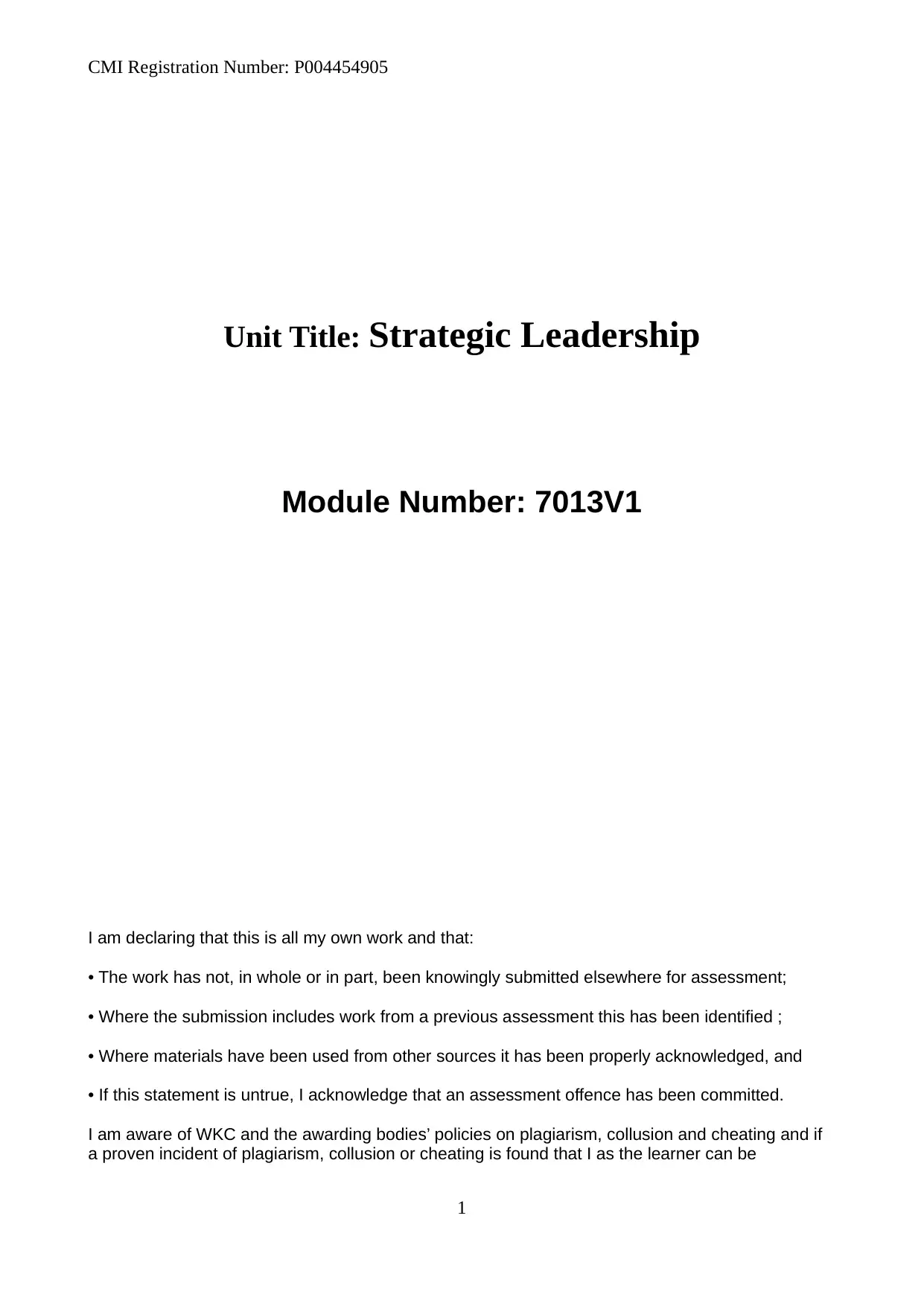
CMI Registration Number: P004454905
Unit Title: Strategic Leadership
Module Number: 7013V1
I am declaring that this is all my own work and that:
• The work has not, in whole or in part, been knowingly submitted elsewhere for assessment;
• Where the submission includes work from a previous assessment this has been identified ;
• Where materials have been used from other sources it has been properly acknowledged, and
• If this statement is untrue, I acknowledge that an assessment offence has been committed.
I am aware of WKC and the awarding bodies’ policies on plagiarism, collusion and cheating and if
a proven incident of plagiarism, collusion or cheating is found that I as the learner can be
1
Unit Title: Strategic Leadership
Module Number: 7013V1
I am declaring that this is all my own work and that:
• The work has not, in whole or in part, been knowingly submitted elsewhere for assessment;
• Where the submission includes work from a previous assessment this has been identified ;
• Where materials have been used from other sources it has been properly acknowledged, and
• If this statement is untrue, I acknowledge that an assessment offence has been committed.
I am aware of WKC and the awarding bodies’ policies on plagiarism, collusion and cheating and if
a proven incident of plagiarism, collusion or cheating is found that I as the learner can be
1
Paraphrase This Document
Need a fresh take? Get an instant paraphrase of this document with our AI Paraphraser

CMI Registration Number: P004454905
withdrawn from the course; that the Home Office will be informed and I may have my registration to
the qualification removed.
2
withdrawn from the course; that the Home Office will be informed and I may have my registration to
the qualification removed.
2
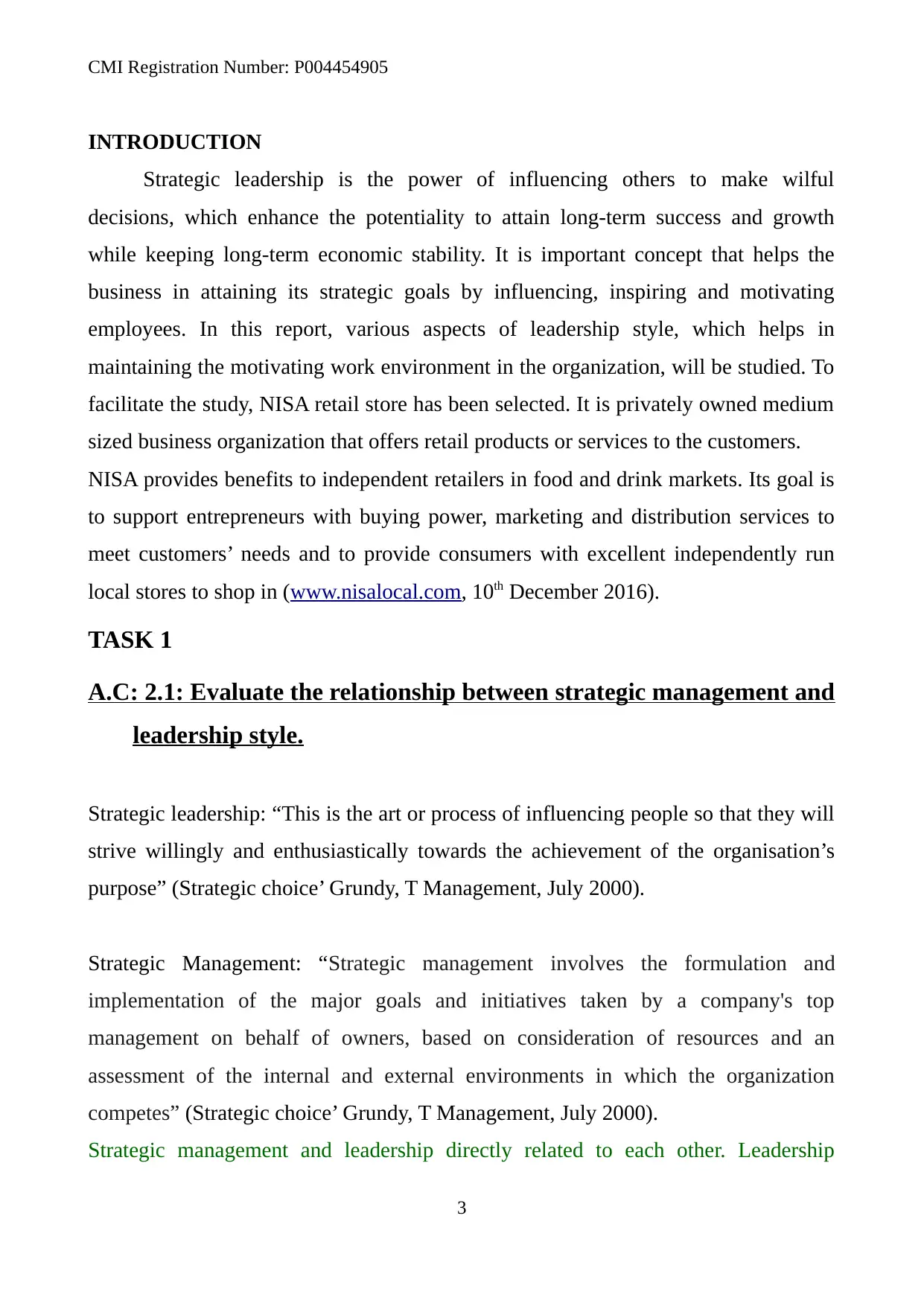
CMI Registration Number: P004454905
INTRODUCTION
Strategic leadership is the power of influencing others to make wilful
decisions, which enhance the potentiality to attain long-term success and growth
while keeping long-term economic stability. It is important concept that helps the
business in attaining its strategic goals by influencing, inspiring and motivating
employees. In this report, various aspects of leadership style, which helps in
maintaining the motivating work environment in the organization, will be studied. To
facilitate the study, NISA retail store has been selected. It is privately owned medium
sized business organization that offers retail products or services to the customers.
NISA provides benefits to independent retailers in food and drink markets. Its goal is
to support entrepreneurs with buying power, marketing and distribution services to
meet customers’ needs and to provide consumers with excellent independently run
local stores to shop in (www.nisalocal.com, 10th December 2016).
TASK 1
A.C: 2.1: Evaluate the relationship between strategic management and
leadership style.
Strategic leadership: “This is the art or process of influencing people so that they will
strive willingly and enthusiastically towards the achievement of the organisation’s
purpose” (Strategic choice’ Grundy, T Management, July 2000).
Strategic Management: “Strategic management involves the formulation and
implementation of the major goals and initiatives taken by a company's top
management on behalf of owners, based on consideration of resources and an
assessment of the internal and external environments in which the organization
competes” (Strategic choice’ Grundy, T Management, July 2000).
Strategic management and leadership directly related to each other. Leadership
3
INTRODUCTION
Strategic leadership is the power of influencing others to make wilful
decisions, which enhance the potentiality to attain long-term success and growth
while keeping long-term economic stability. It is important concept that helps the
business in attaining its strategic goals by influencing, inspiring and motivating
employees. In this report, various aspects of leadership style, which helps in
maintaining the motivating work environment in the organization, will be studied. To
facilitate the study, NISA retail store has been selected. It is privately owned medium
sized business organization that offers retail products or services to the customers.
NISA provides benefits to independent retailers in food and drink markets. Its goal is
to support entrepreneurs with buying power, marketing and distribution services to
meet customers’ needs and to provide consumers with excellent independently run
local stores to shop in (www.nisalocal.com, 10th December 2016).
TASK 1
A.C: 2.1: Evaluate the relationship between strategic management and
leadership style.
Strategic leadership: “This is the art or process of influencing people so that they will
strive willingly and enthusiastically towards the achievement of the organisation’s
purpose” (Strategic choice’ Grundy, T Management, July 2000).
Strategic Management: “Strategic management involves the formulation and
implementation of the major goals and initiatives taken by a company's top
management on behalf of owners, based on consideration of resources and an
assessment of the internal and external environments in which the organization
competes” (Strategic choice’ Grundy, T Management, July 2000).
Strategic management and leadership directly related to each other. Leadership
3
⊘ This is a preview!⊘
Do you want full access?
Subscribe today to unlock all pages.

Trusted by 1+ million students worldwide
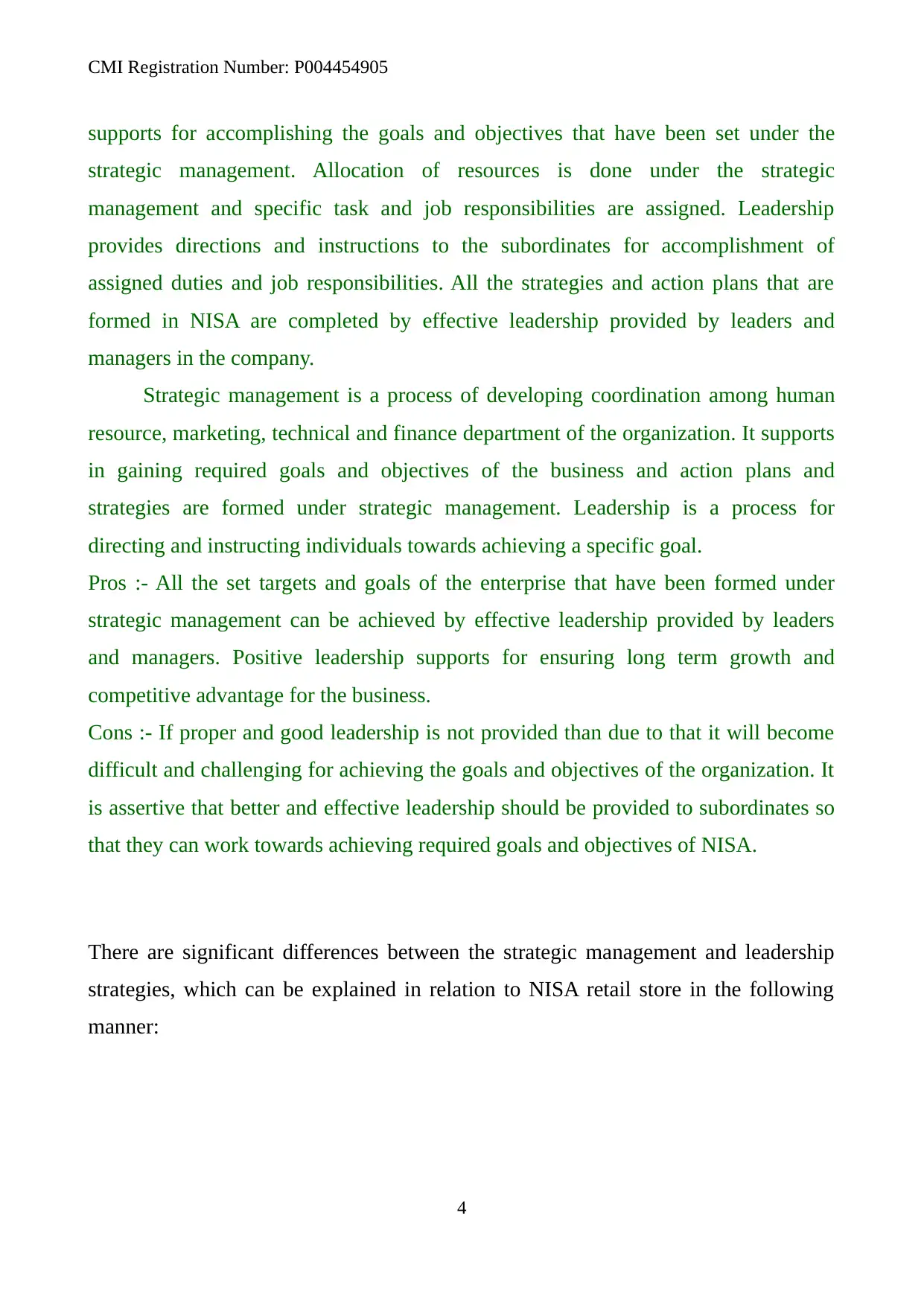
CMI Registration Number: P004454905
supports for accomplishing the goals and objectives that have been set under the
strategic management. Allocation of resources is done under the strategic
management and specific task and job responsibilities are assigned. Leadership
provides directions and instructions to the subordinates for accomplishment of
assigned duties and job responsibilities. All the strategies and action plans that are
formed in NISA are completed by effective leadership provided by leaders and
managers in the company.
Strategic management is a process of developing coordination among human
resource, marketing, technical and finance department of the organization. It supports
in gaining required goals and objectives of the business and action plans and
strategies are formed under strategic management. Leadership is a process for
directing and instructing individuals towards achieving a specific goal.
Pros :- All the set targets and goals of the enterprise that have been formed under
strategic management can be achieved by effective leadership provided by leaders
and managers. Positive leadership supports for ensuring long term growth and
competitive advantage for the business.
Cons :- If proper and good leadership is not provided than due to that it will become
difficult and challenging for achieving the goals and objectives of the organization. It
is assertive that better and effective leadership should be provided to subordinates so
that they can work towards achieving required goals and objectives of NISA.
There are significant differences between the strategic management and leadership
strategies, which can be explained in relation to NISA retail store in the following
manner:
4
supports for accomplishing the goals and objectives that have been set under the
strategic management. Allocation of resources is done under the strategic
management and specific task and job responsibilities are assigned. Leadership
provides directions and instructions to the subordinates for accomplishment of
assigned duties and job responsibilities. All the strategies and action plans that are
formed in NISA are completed by effective leadership provided by leaders and
managers in the company.
Strategic management is a process of developing coordination among human
resource, marketing, technical and finance department of the organization. It supports
in gaining required goals and objectives of the business and action plans and
strategies are formed under strategic management. Leadership is a process for
directing and instructing individuals towards achieving a specific goal.
Pros :- All the set targets and goals of the enterprise that have been formed under
strategic management can be achieved by effective leadership provided by leaders
and managers. Positive leadership supports for ensuring long term growth and
competitive advantage for the business.
Cons :- If proper and good leadership is not provided than due to that it will become
difficult and challenging for achieving the goals and objectives of the organization. It
is assertive that better and effective leadership should be provided to subordinates so
that they can work towards achieving required goals and objectives of NISA.
There are significant differences between the strategic management and leadership
strategies, which can be explained in relation to NISA retail store in the following
manner:
4
Paraphrase This Document
Need a fresh take? Get an instant paraphrase of this document with our AI Paraphraser
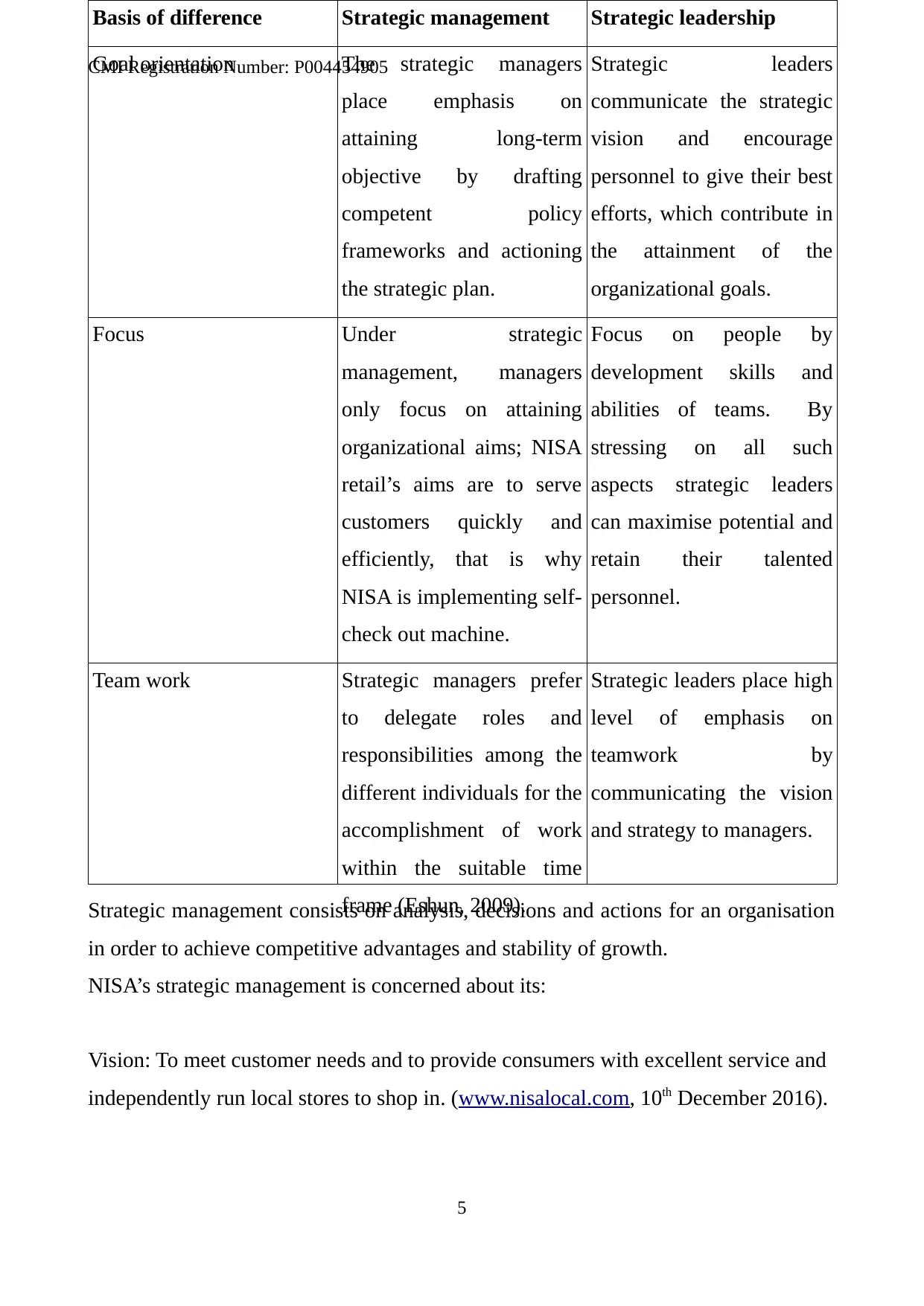
CMI Registration Number: P004454905
Strategic management consists on analysis, decisions and actions for an organisation
in order to achieve competitive advantages and stability of growth.
NISA’s strategic management is concerned about its:
Vision: To meet customer needs and to provide consumers with excellent service and
independently run local stores to shop in. (www.nisalocal.com, 10th December 2016).
5
Basis of difference Strategic management Strategic leadership
Goal orientation The strategic managers
place emphasis on
attaining long-term
objective by drafting
competent policy
frameworks and actioning
the strategic plan.
Strategic leaders
communicate the strategic
vision and encourage
personnel to give their best
efforts, which contribute in
the attainment of the
organizational goals.
Focus Under strategic
management, managers
only focus on attaining
organizational aims; NISA
retail’s aims are to serve
customers quickly and
efficiently, that is why
NISA is implementing self-
check out machine.
Focus on people by
development skills and
abilities of teams. By
stressing on all such
aspects strategic leaders
can maximise potential and
retain their talented
personnel.
Team work Strategic managers prefer
to delegate roles and
responsibilities among the
different individuals for the
accomplishment of work
within the suitable time
frame (Eshun, 2009).
Strategic leaders place high
level of emphasis on
teamwork by
communicating the vision
and strategy to managers.
Strategic management consists on analysis, decisions and actions for an organisation
in order to achieve competitive advantages and stability of growth.
NISA’s strategic management is concerned about its:
Vision: To meet customer needs and to provide consumers with excellent service and
independently run local stores to shop in. (www.nisalocal.com, 10th December 2016).
5
Basis of difference Strategic management Strategic leadership
Goal orientation The strategic managers
place emphasis on
attaining long-term
objective by drafting
competent policy
frameworks and actioning
the strategic plan.
Strategic leaders
communicate the strategic
vision and encourage
personnel to give their best
efforts, which contribute in
the attainment of the
organizational goals.
Focus Under strategic
management, managers
only focus on attaining
organizational aims; NISA
retail’s aims are to serve
customers quickly and
efficiently, that is why
NISA is implementing self-
check out machine.
Focus on people by
development skills and
abilities of teams. By
stressing on all such
aspects strategic leaders
can maximise potential and
retain their talented
personnel.
Team work Strategic managers prefer
to delegate roles and
responsibilities among the
different individuals for the
accomplishment of work
within the suitable time
frame (Eshun, 2009).
Strategic leaders place high
level of emphasis on
teamwork by
communicating the vision
and strategy to managers.
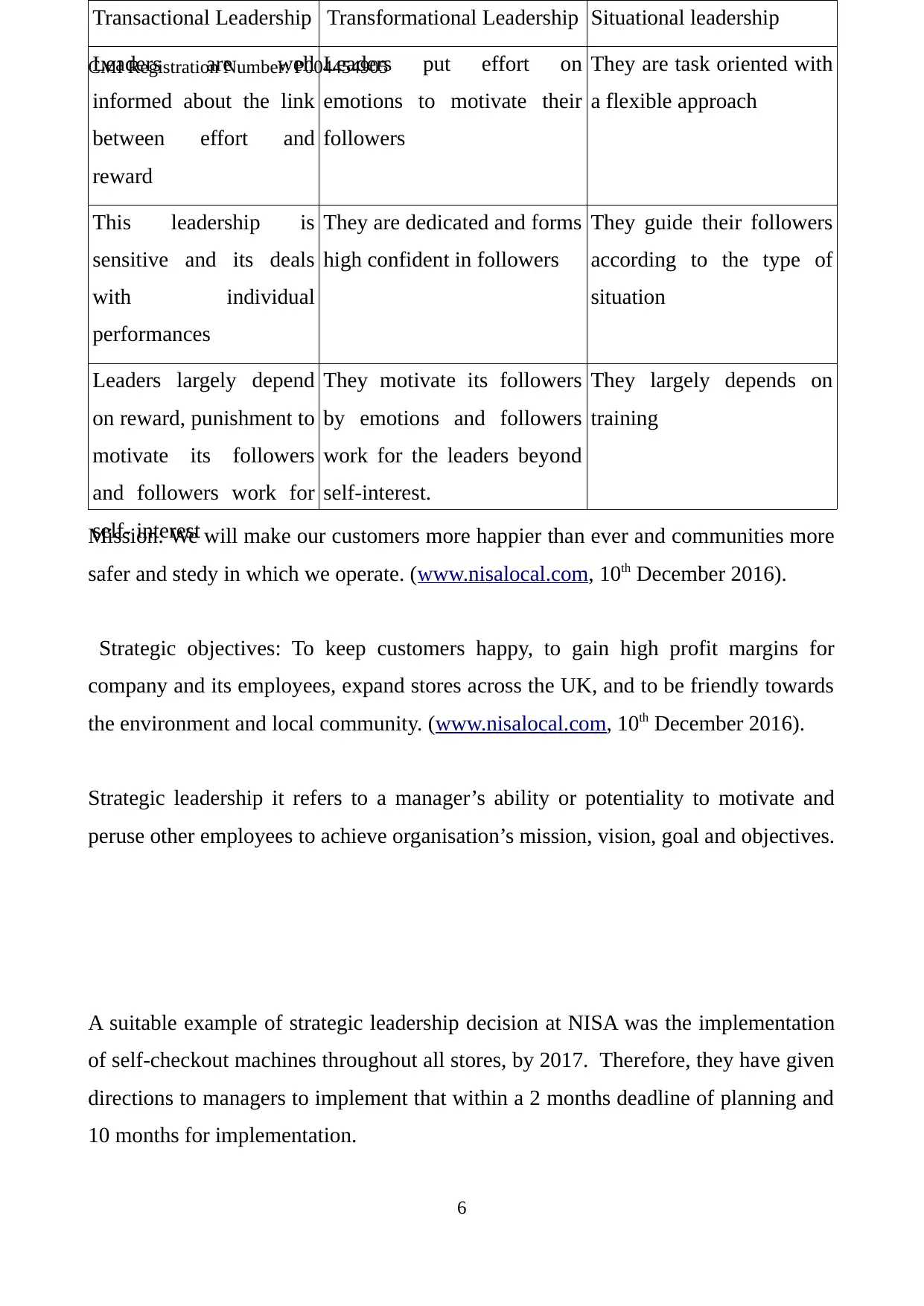
CMI Registration Number: P004454905
Mission: We will make our customers more happier than ever and communities more
safer and stedy in which we operate. (www.nisalocal.com, 10th December 2016).
Strategic objectives: To keep customers happy, to gain high profit margins for
company and its employees, expand stores across the UK, and to be friendly towards
the environment and local community. (www.nisalocal.com, 10th December 2016).
Strategic leadership it refers to a manager’s ability or potentiality to motivate and
peruse other employees to achieve organisation’s mission, vision, goal and objectives.
A suitable example of strategic leadership decision at NISA was the implementation
of self-checkout machines throughout all stores, by 2017. Therefore, they have given
directions to managers to implement that within a 2 months deadline of planning and
10 months for implementation.
6
Transactional Leadership Transformational Leadership Situational leadership
Leaders are well
informed about the link
between effort and
reward
Leaders put effort on
emotions to motivate their
followers
They are task oriented with
a flexible approach
This leadership is
sensitive and its deals
with individual
performances
They are dedicated and forms
high confident in followers
They guide their followers
according to the type of
situation
Leaders largely depend
on reward, punishment to
motivate its followers
and followers work for
self- interest
They motivate its followers
by emotions and followers
work for the leaders beyond
self-interest.
They largely depends on
training
Mission: We will make our customers more happier than ever and communities more
safer and stedy in which we operate. (www.nisalocal.com, 10th December 2016).
Strategic objectives: To keep customers happy, to gain high profit margins for
company and its employees, expand stores across the UK, and to be friendly towards
the environment and local community. (www.nisalocal.com, 10th December 2016).
Strategic leadership it refers to a manager’s ability or potentiality to motivate and
peruse other employees to achieve organisation’s mission, vision, goal and objectives.
A suitable example of strategic leadership decision at NISA was the implementation
of self-checkout machines throughout all stores, by 2017. Therefore, they have given
directions to managers to implement that within a 2 months deadline of planning and
10 months for implementation.
6
Transactional Leadership Transformational Leadership Situational leadership
Leaders are well
informed about the link
between effort and
reward
Leaders put effort on
emotions to motivate their
followers
They are task oriented with
a flexible approach
This leadership is
sensitive and its deals
with individual
performances
They are dedicated and forms
high confident in followers
They guide their followers
according to the type of
situation
Leaders largely depend
on reward, punishment to
motivate its followers
and followers work for
self- interest
They motivate its followers
by emotions and followers
work for the leaders beyond
self-interest.
They largely depends on
training
⊘ This is a preview!⊘
Do you want full access?
Subscribe today to unlock all pages.

Trusted by 1+ million students worldwide
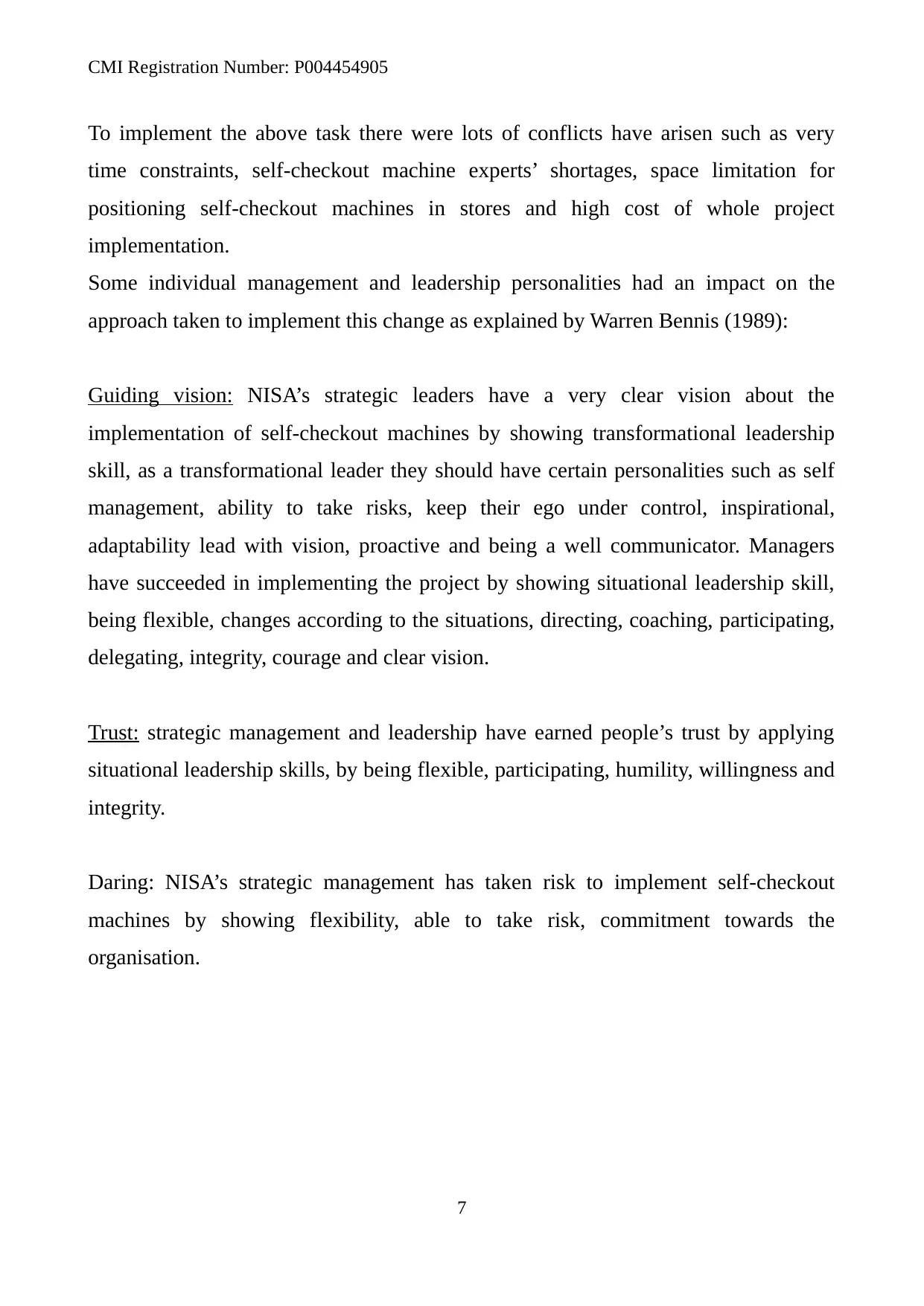
CMI Registration Number: P004454905
To implement the above task there were lots of conflicts have arisen such as very
time constraints, self-checkout machine experts’ shortages, space limitation for
positioning self-checkout machines in stores and high cost of whole project
implementation.
Some individual management and leadership personalities had an impact on the
approach taken to implement this change as explained by Warren Bennis (1989):
Guiding vision: NISA’s strategic leaders have a very clear vision about the
implementation of self-checkout machines by showing transformational leadership
skill, as a transformational leader they should have certain personalities such as self
management, ability to take risks, keep their ego under control, inspirational,
adaptability lead with vision, proactive and being a well communicator. Managers
have succeeded in implementing the project by showing situational leadership skill,
being flexible, changes according to the situations, directing, coaching, participating,
delegating, integrity, courage and clear vision.
Trust: strategic management and leadership have earned people’s trust by applying
situational leadership skills, by being flexible, participating, humility, willingness and
integrity.
Daring: NISA’s strategic management has taken risk to implement self-checkout
machines by showing flexibility, able to take risk, commitment towards the
organisation.
7
To implement the above task there were lots of conflicts have arisen such as very
time constraints, self-checkout machine experts’ shortages, space limitation for
positioning self-checkout machines in stores and high cost of whole project
implementation.
Some individual management and leadership personalities had an impact on the
approach taken to implement this change as explained by Warren Bennis (1989):
Guiding vision: NISA’s strategic leaders have a very clear vision about the
implementation of self-checkout machines by showing transformational leadership
skill, as a transformational leader they should have certain personalities such as self
management, ability to take risks, keep their ego under control, inspirational,
adaptability lead with vision, proactive and being a well communicator. Managers
have succeeded in implementing the project by showing situational leadership skill,
being flexible, changes according to the situations, directing, coaching, participating,
delegating, integrity, courage and clear vision.
Trust: strategic management and leadership have earned people’s trust by applying
situational leadership skills, by being flexible, participating, humility, willingness and
integrity.
Daring: NISA’s strategic management has taken risk to implement self-checkout
machines by showing flexibility, able to take risk, commitment towards the
organisation.
7
Paraphrase This Document
Need a fresh take? Get an instant paraphrase of this document with our AI Paraphraser
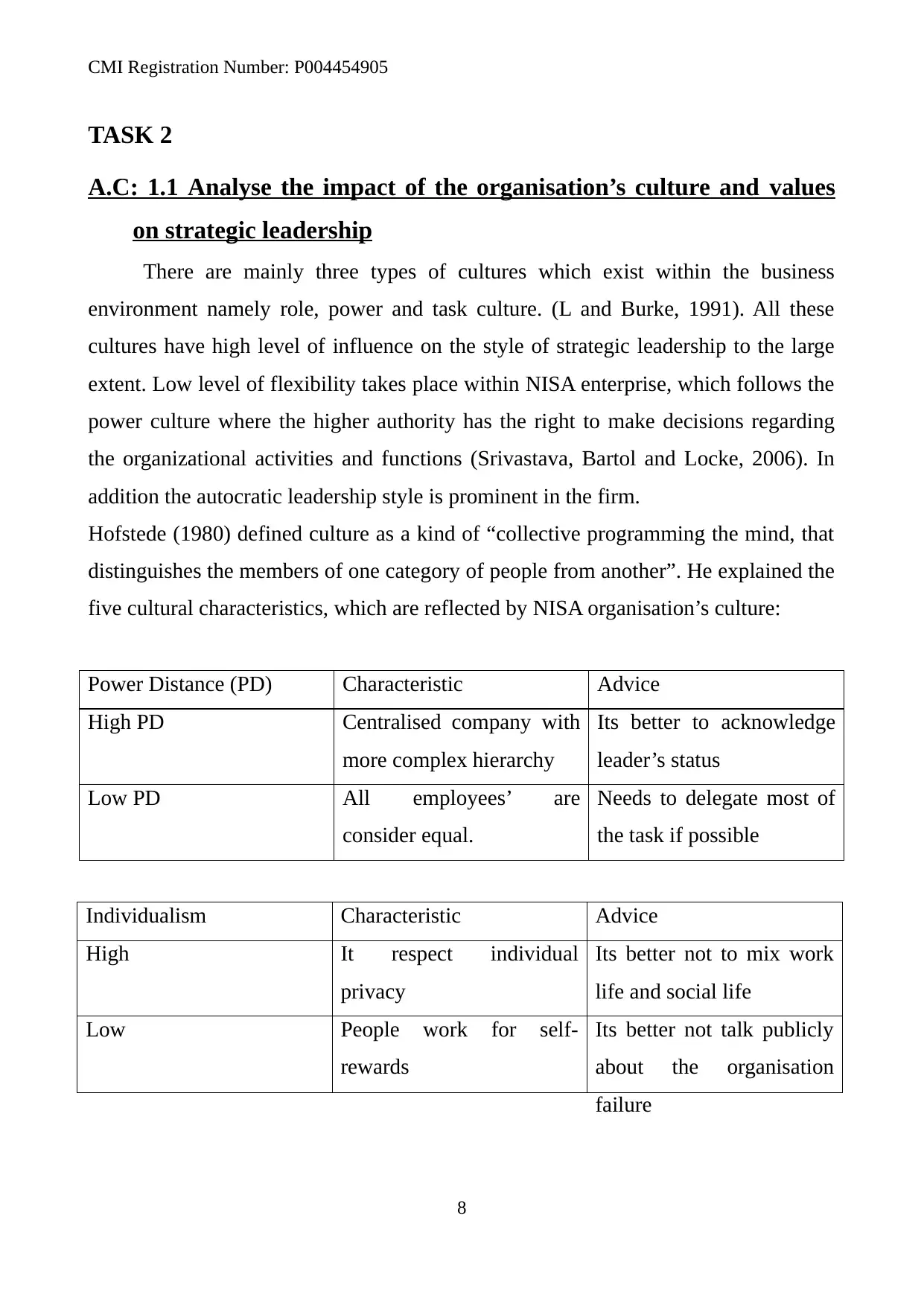
CMI Registration Number: P004454905
TASK 2
A.C: 1.1 Analyse the impact of the organisation’s culture and values
on strategic leadership
There are mainly three types of cultures which exist within the business
environment namely role, power and task culture. (L and Burke, 1991). All these
cultures have high level of influence on the style of strategic leadership to the large
extent. Low level of flexibility takes place within NISA enterprise, which follows the
power culture where the higher authority has the right to make decisions regarding
the organizational activities and functions (Srivastava, Bartol and Locke, 2006). In
addition the autocratic leadership style is prominent in the firm.
Hofstede (1980) defined culture as a kind of “collective programming the mind, that
distinguishes the members of one category of people from another”. He explained the
five cultural characteristics, which are reflected by NISA organisation’s culture:
Power Distance (PD) Characteristic Advice
High PD Centralised company with
more complex hierarchy
Its better to acknowledge
leader’s status
Low PD All employees’ are
consider equal.
Needs to delegate most of
the task if possible
8
Individualism Characteristic Advice
High It respect individual
privacy
Its better not to mix work
life and social life
Low People work for self-
rewards
Its better not talk publicly
about the organisation
failure
TASK 2
A.C: 1.1 Analyse the impact of the organisation’s culture and values
on strategic leadership
There are mainly three types of cultures which exist within the business
environment namely role, power and task culture. (L and Burke, 1991). All these
cultures have high level of influence on the style of strategic leadership to the large
extent. Low level of flexibility takes place within NISA enterprise, which follows the
power culture where the higher authority has the right to make decisions regarding
the organizational activities and functions (Srivastava, Bartol and Locke, 2006). In
addition the autocratic leadership style is prominent in the firm.
Hofstede (1980) defined culture as a kind of “collective programming the mind, that
distinguishes the members of one category of people from another”. He explained the
five cultural characteristics, which are reflected by NISA organisation’s culture:
Power Distance (PD) Characteristic Advice
High PD Centralised company with
more complex hierarchy
Its better to acknowledge
leader’s status
Low PD All employees’ are
consider equal.
Needs to delegate most of
the task if possible
8
Individualism Characteristic Advice
High It respect individual
privacy
Its better not to mix work
life and social life
Low People work for self-
rewards
Its better not talk publicly
about the organisation
failure
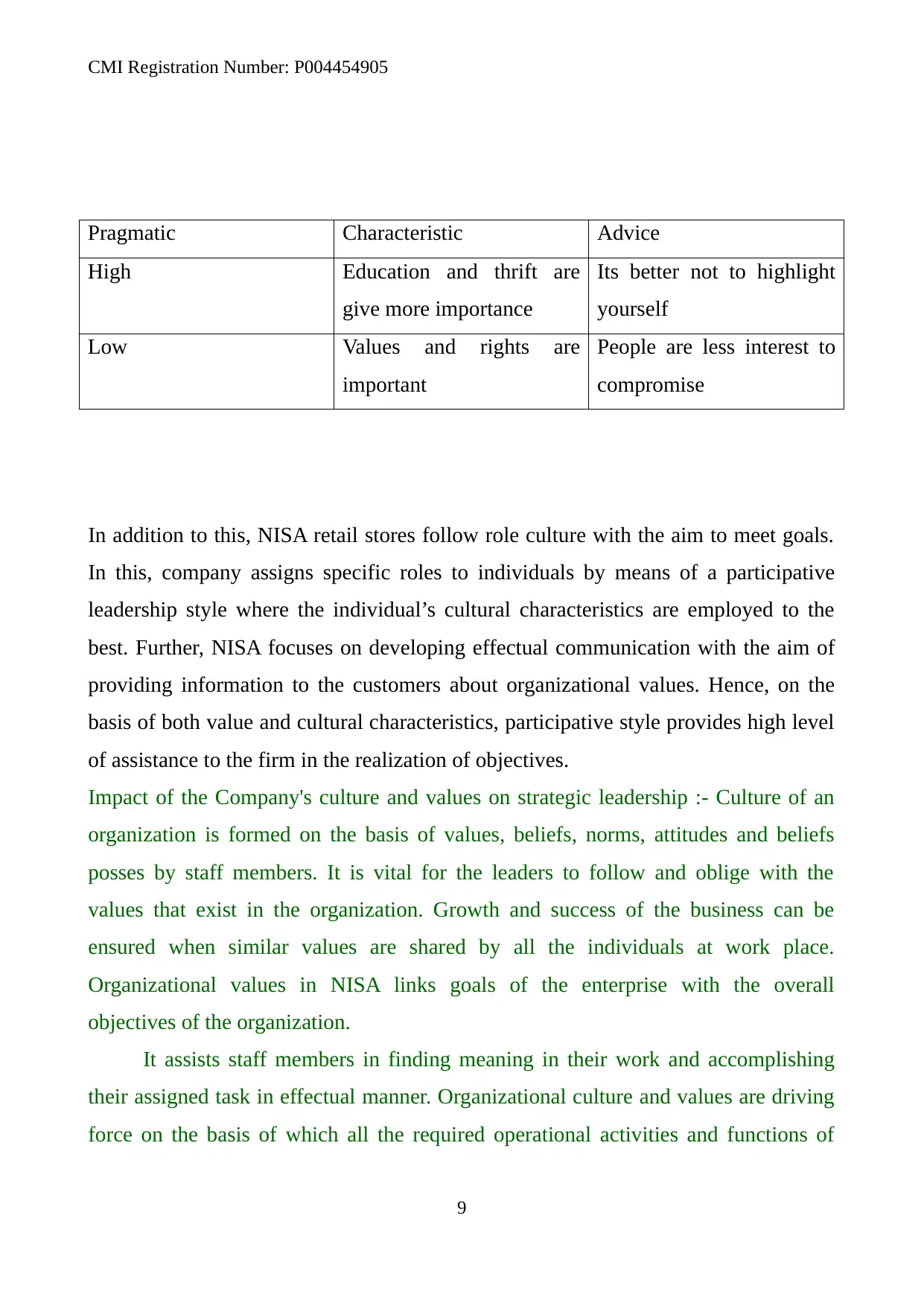
CMI Registration Number: P004454905
Pragmatic Characteristic Advice
High Education and thrift are
give more importance
Its better not to highlight
yourself
Low Values and rights are
important
People are less interest to
compromise
In addition to this, NISA retail stores follow role culture with the aim to meet goals.
In this, company assigns specific roles to individuals by means of a participative
leadership style where the individual’s cultural characteristics are employed to the
best. Further, NISA focuses on developing effectual communication with the aim of
providing information to the customers about organizational values. Hence, on the
basis of both value and cultural characteristics, participative style provides high level
of assistance to the firm in the realization of objectives.
Impact of the Company's culture and values on strategic leadership :- Culture of an
organization is formed on the basis of values, beliefs, norms, attitudes and beliefs
posses by staff members. It is vital for the leaders to follow and oblige with the
values that exist in the organization. Growth and success of the business can be
ensured when similar values are shared by all the individuals at work place.
Organizational values in NISA links goals of the enterprise with the overall
objectives of the organization.
It assists staff members in finding meaning in their work and accomplishing
their assigned task in effectual manner. Organizational culture and values are driving
force on the basis of which all the required operational activities and functions of
9
Pragmatic Characteristic Advice
High Education and thrift are
give more importance
Its better not to highlight
yourself
Low Values and rights are
important
People are less interest to
compromise
In addition to this, NISA retail stores follow role culture with the aim to meet goals.
In this, company assigns specific roles to individuals by means of a participative
leadership style where the individual’s cultural characteristics are employed to the
best. Further, NISA focuses on developing effectual communication with the aim of
providing information to the customers about organizational values. Hence, on the
basis of both value and cultural characteristics, participative style provides high level
of assistance to the firm in the realization of objectives.
Impact of the Company's culture and values on strategic leadership :- Culture of an
organization is formed on the basis of values, beliefs, norms, attitudes and beliefs
posses by staff members. It is vital for the leaders to follow and oblige with the
values that exist in the organization. Growth and success of the business can be
ensured when similar values are shared by all the individuals at work place.
Organizational values in NISA links goals of the enterprise with the overall
objectives of the organization.
It assists staff members in finding meaning in their work and accomplishing
their assigned task in effectual manner. Organizational culture and values are driving
force on the basis of which all the required operational activities and functions of
9
⊘ This is a preview!⊘
Do you want full access?
Subscribe today to unlock all pages.

Trusted by 1+ million students worldwide
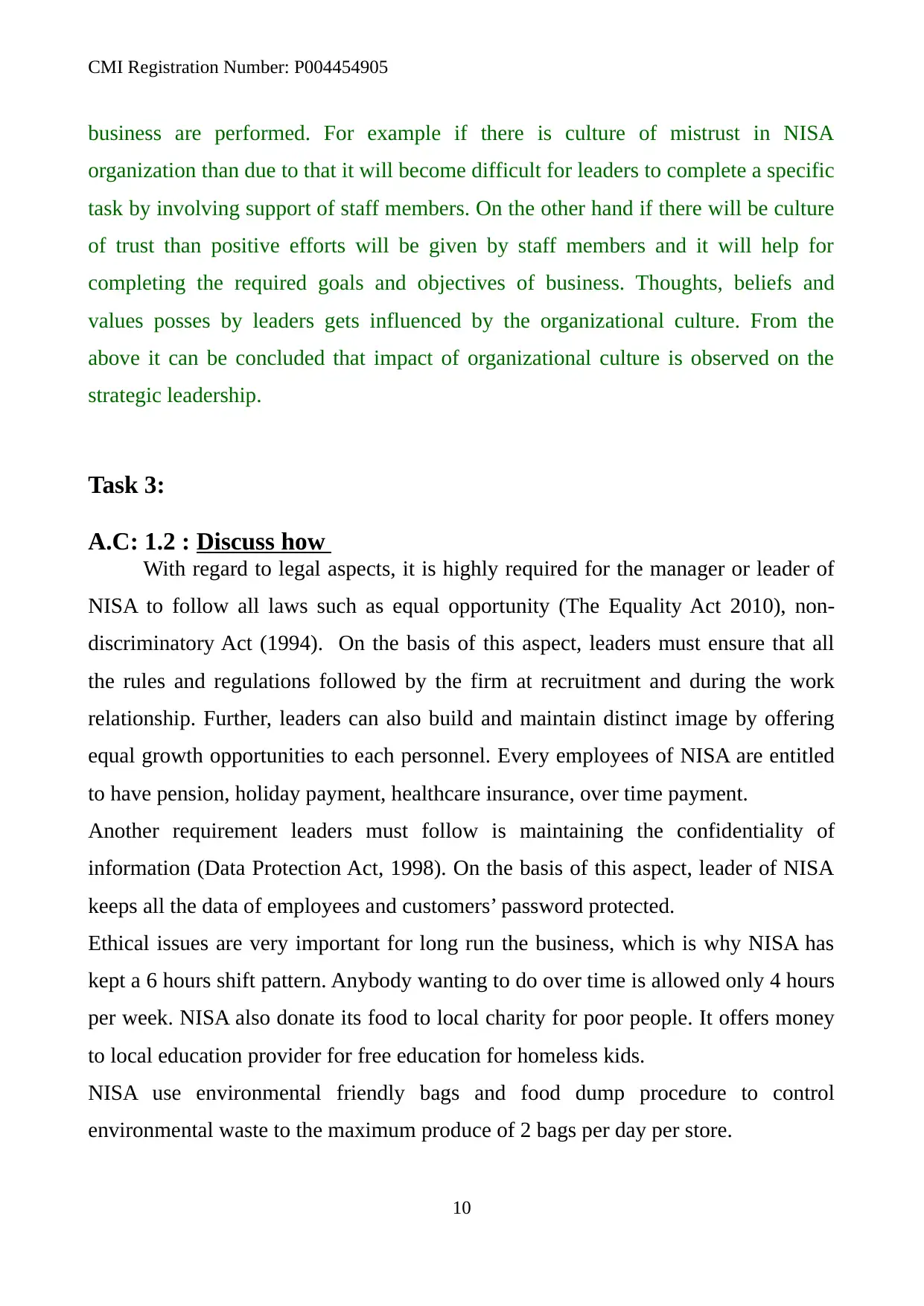
CMI Registration Number: P004454905
business are performed. For example if there is culture of mistrust in NISA
organization than due to that it will become difficult for leaders to complete a specific
task by involving support of staff members. On the other hand if there will be culture
of trust than positive efforts will be given by staff members and it will help for
completing the required goals and objectives of business. Thoughts, beliefs and
values posses by leaders gets influenced by the organizational culture. From the
above it can be concluded that impact of organizational culture is observed on the
strategic leadership.
Task 3:
A.C: 1.2 : Discuss how
With regard to legal aspects, it is highly required for the manager or leader of
NISA to follow all laws such as equal opportunity (The Equality Act 2010), non-
discriminatory Act (1994). On the basis of this aspect, leaders must ensure that all
the rules and regulations followed by the firm at recruitment and during the work
relationship. Further, leaders can also build and maintain distinct image by offering
equal growth opportunities to each personnel. Every employees of NISA are entitled
to have pension, holiday payment, healthcare insurance, over time payment.
Another requirement leaders must follow is maintaining the confidentiality of
information (Data Protection Act, 1998). On the basis of this aspect, leader of NISA
keeps all the data of employees and customers’ password protected.
Ethical issues are very important for long run the business, which is why NISA has
kept a 6 hours shift pattern. Anybody wanting to do over time is allowed only 4 hours
per week. NISA also donate its food to local charity for poor people. It offers money
to local education provider for free education for homeless kids.
NISA use environmental friendly bags and food dump procedure to control
environmental waste to the maximum produce of 2 bags per day per store.
10
business are performed. For example if there is culture of mistrust in NISA
organization than due to that it will become difficult for leaders to complete a specific
task by involving support of staff members. On the other hand if there will be culture
of trust than positive efforts will be given by staff members and it will help for
completing the required goals and objectives of business. Thoughts, beliefs and
values posses by leaders gets influenced by the organizational culture. From the
above it can be concluded that impact of organizational culture is observed on the
strategic leadership.
Task 3:
A.C: 1.2 : Discuss how
With regard to legal aspects, it is highly required for the manager or leader of
NISA to follow all laws such as equal opportunity (The Equality Act 2010), non-
discriminatory Act (1994). On the basis of this aspect, leaders must ensure that all
the rules and regulations followed by the firm at recruitment and during the work
relationship. Further, leaders can also build and maintain distinct image by offering
equal growth opportunities to each personnel. Every employees of NISA are entitled
to have pension, holiday payment, healthcare insurance, over time payment.
Another requirement leaders must follow is maintaining the confidentiality of
information (Data Protection Act, 1998). On the basis of this aspect, leader of NISA
keeps all the data of employees and customers’ password protected.
Ethical issues are very important for long run the business, which is why NISA has
kept a 6 hours shift pattern. Anybody wanting to do over time is allowed only 4 hours
per week. NISA also donate its food to local charity for poor people. It offers money
to local education provider for free education for homeless kids.
NISA use environmental friendly bags and food dump procedure to control
environmental waste to the maximum produce of 2 bags per day per store.
10
Paraphrase This Document
Need a fresh take? Get an instant paraphrase of this document with our AI Paraphraser
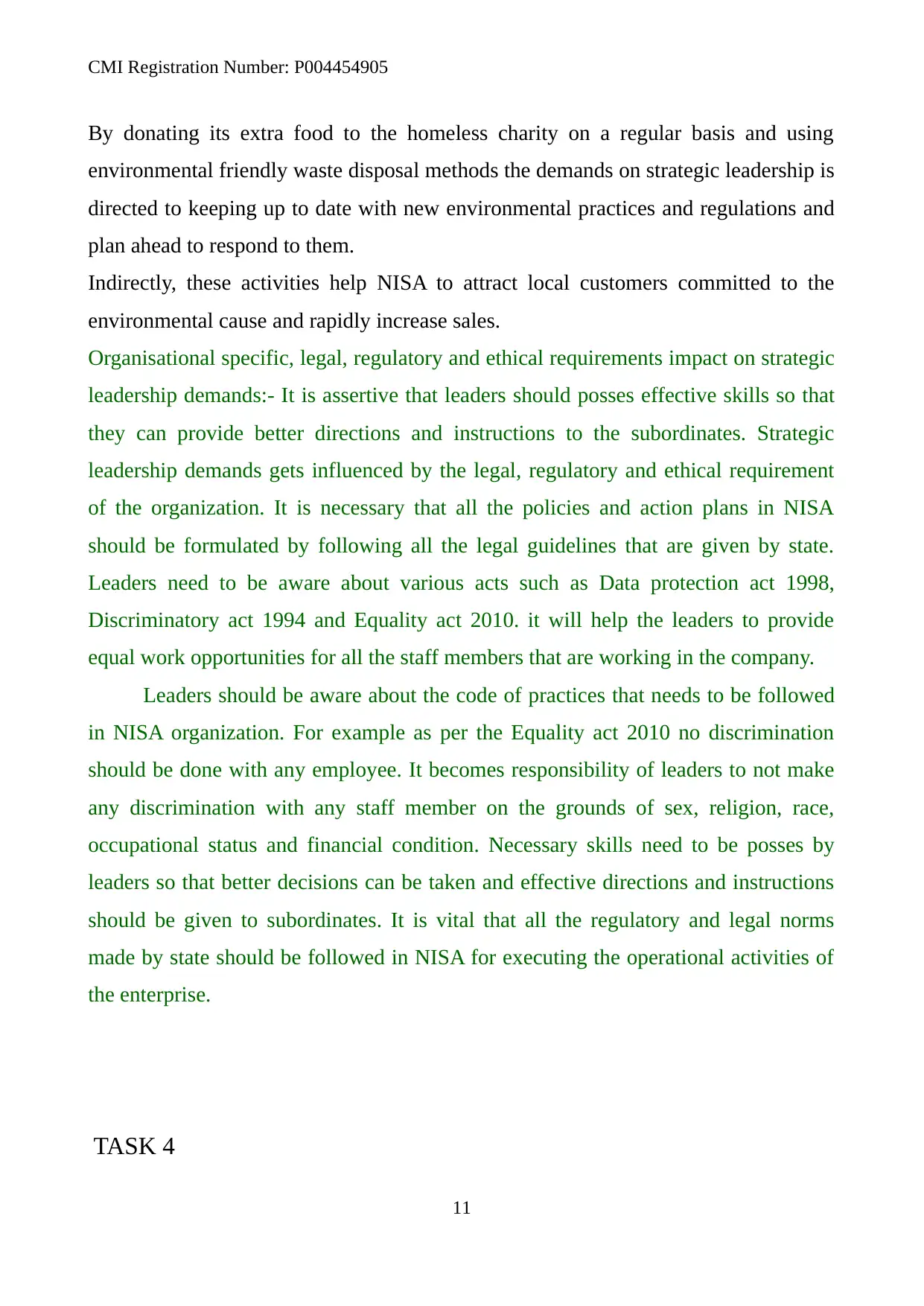
CMI Registration Number: P004454905
By donating its extra food to the homeless charity on a regular basis and using
environmental friendly waste disposal methods the demands on strategic leadership is
directed to keeping up to date with new environmental practices and regulations and
plan ahead to respond to them.
Indirectly, these activities help NISA to attract local customers committed to the
environmental cause and rapidly increase sales.
Organisational specific, legal, regulatory and ethical requirements impact on strategic
leadership demands:- It is assertive that leaders should posses effective skills so that
they can provide better directions and instructions to the subordinates. Strategic
leadership demands gets influenced by the legal, regulatory and ethical requirement
of the organization. It is necessary that all the policies and action plans in NISA
should be formulated by following all the legal guidelines that are given by state.
Leaders need to be aware about various acts such as Data protection act 1998,
Discriminatory act 1994 and Equality act 2010. it will help the leaders to provide
equal work opportunities for all the staff members that are working in the company.
Leaders should be aware about the code of practices that needs to be followed
in NISA organization. For example as per the Equality act 2010 no discrimination
should be done with any employee. It becomes responsibility of leaders to not make
any discrimination with any staff member on the grounds of sex, religion, race,
occupational status and financial condition. Necessary skills need to be posses by
leaders so that better decisions can be taken and effective directions and instructions
should be given to subordinates. It is vital that all the regulatory and legal norms
made by state should be followed in NISA for executing the operational activities of
the enterprise.
TASK 4
11
By donating its extra food to the homeless charity on a regular basis and using
environmental friendly waste disposal methods the demands on strategic leadership is
directed to keeping up to date with new environmental practices and regulations and
plan ahead to respond to them.
Indirectly, these activities help NISA to attract local customers committed to the
environmental cause and rapidly increase sales.
Organisational specific, legal, regulatory and ethical requirements impact on strategic
leadership demands:- It is assertive that leaders should posses effective skills so that
they can provide better directions and instructions to the subordinates. Strategic
leadership demands gets influenced by the legal, regulatory and ethical requirement
of the organization. It is necessary that all the policies and action plans in NISA
should be formulated by following all the legal guidelines that are given by state.
Leaders need to be aware about various acts such as Data protection act 1998,
Discriminatory act 1994 and Equality act 2010. it will help the leaders to provide
equal work opportunities for all the staff members that are working in the company.
Leaders should be aware about the code of practices that needs to be followed
in NISA organization. For example as per the Equality act 2010 no discrimination
should be done with any employee. It becomes responsibility of leaders to not make
any discrimination with any staff member on the grounds of sex, religion, race,
occupational status and financial condition. Necessary skills need to be posses by
leaders so that better decisions can be taken and effective directions and instructions
should be given to subordinates. It is vital that all the regulatory and legal norms
made by state should be followed in NISA for executing the operational activities of
the enterprise.
TASK 4
11
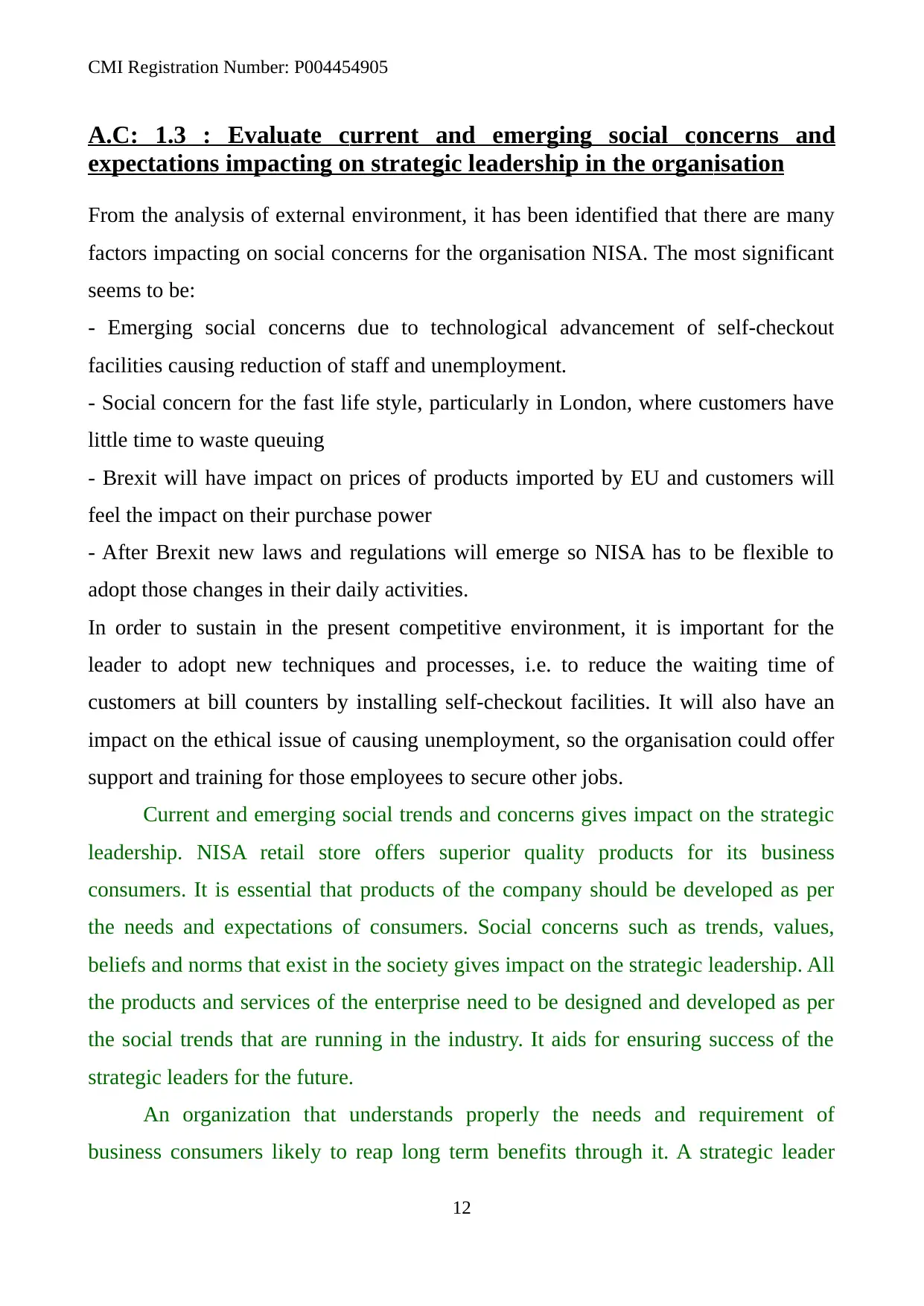
CMI Registration Number: P004454905
A.C: 1.3 : Evaluate current and emerging social concerns and
expectations impacting on strategic leadership in the organisation
From the analysis of external environment, it has been identified that there are many
factors impacting on social concerns for the organisation NISA. The most significant
seems to be:
- Emerging social concerns due to technological advancement of self-checkout
facilities causing reduction of staff and unemployment.
- Social concern for the fast life style, particularly in London, where customers have
little time to waste queuing
- Brexit will have impact on prices of products imported by EU and customers will
feel the impact on their purchase power
- After Brexit new laws and regulations will emerge so NISA has to be flexible to
adopt those changes in their daily activities.
In order to sustain in the present competitive environment, it is important for the
leader to adopt new techniques and processes, i.e. to reduce the waiting time of
customers at bill counters by installing self-checkout facilities. It will also have an
impact on the ethical issue of causing unemployment, so the organisation could offer
support and training for those employees to secure other jobs.
Current and emerging social trends and concerns gives impact on the strategic
leadership. NISA retail store offers superior quality products for its business
consumers. It is essential that products of the company should be developed as per
the needs and expectations of consumers. Social concerns such as trends, values,
beliefs and norms that exist in the society gives impact on the strategic leadership. All
the products and services of the enterprise need to be designed and developed as per
the social trends that are running in the industry. It aids for ensuring success of the
strategic leaders for the future.
An organization that understands properly the needs and requirement of
business consumers likely to reap long term benefits through it. A strategic leader
12
A.C: 1.3 : Evaluate current and emerging social concerns and
expectations impacting on strategic leadership in the organisation
From the analysis of external environment, it has been identified that there are many
factors impacting on social concerns for the organisation NISA. The most significant
seems to be:
- Emerging social concerns due to technological advancement of self-checkout
facilities causing reduction of staff and unemployment.
- Social concern for the fast life style, particularly in London, where customers have
little time to waste queuing
- Brexit will have impact on prices of products imported by EU and customers will
feel the impact on their purchase power
- After Brexit new laws and regulations will emerge so NISA has to be flexible to
adopt those changes in their daily activities.
In order to sustain in the present competitive environment, it is important for the
leader to adopt new techniques and processes, i.e. to reduce the waiting time of
customers at bill counters by installing self-checkout facilities. It will also have an
impact on the ethical issue of causing unemployment, so the organisation could offer
support and training for those employees to secure other jobs.
Current and emerging social trends and concerns gives impact on the strategic
leadership. NISA retail store offers superior quality products for its business
consumers. It is essential that products of the company should be developed as per
the needs and expectations of consumers. Social concerns such as trends, values,
beliefs and norms that exist in the society gives impact on the strategic leadership. All
the products and services of the enterprise need to be designed and developed as per
the social trends that are running in the industry. It aids for ensuring success of the
strategic leaders for the future.
An organization that understands properly the needs and requirement of
business consumers likely to reap long term benefits through it. A strategic leader
12
⊘ This is a preview!⊘
Do you want full access?
Subscribe today to unlock all pages.

Trusted by 1+ million students worldwide
1 out of 24
Related Documents
Your All-in-One AI-Powered Toolkit for Academic Success.
+13062052269
info@desklib.com
Available 24*7 on WhatsApp / Email
![[object Object]](/_next/static/media/star-bottom.7253800d.svg)
Unlock your academic potential
Copyright © 2020–2025 A2Z Services. All Rights Reserved. Developed and managed by ZUCOL.





